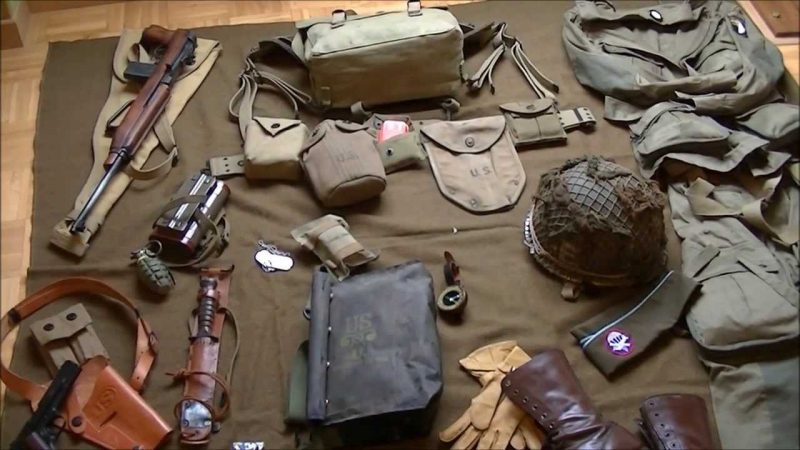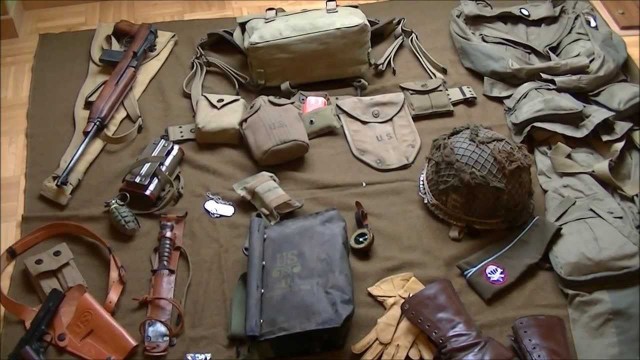Wired Magazine is best known for its showcasing of the very latest gadgets that modern technology has to offer, so its June 2012 article on the gadgets and gear of the American D-Day paratrooper is all the more noteworthy.
D-Day marked the largest seaborne invasion in history. It brought liberation to France from Nazi rule and defeat of the Third Reich on the Western Front.
The pre-dawn work of paratroopers behind the fortified Normandy defences built under Field Marshal Rommel’s watchful eye was dangerous and critical to the success of the Allies at Utah, Omaha, Gold, Juno and Sword beaches later on that fateful day.
The meticulous planning and training for the invasion extended to the kit provided to the troops. Every square inch of a paratrooper’s body was used to carry what was needed to locate rendezvous points upon landing, firepower to neutralize the enemy and survival kits to evade and escape if necessary.
Here are some of the key gear, gadgets and guns that were used:
Compasses
Paratroopers were issued a large compass to be worn on the wrist and smaller more easily hidden compasses that were part of escape and evasion kits. The large compass was a mainstay for a paratrooper to meet up with his fellows upon landing behind the lines, often after being dropped far from the planned position.
The smaller compasses came to be known as “A**hole compasses” as they were small enough that they could be concealed anywhere on the body.
In addition to the small compasses, the escape and evasion kits also contained a tiny steel hacksaw and a two-sided map made of Rayon and sometimes cash.
Rifles
The M1 Garand was the standard weapon for most US soldiers during World War II. It was a semi-automatic that gave it a marked advantage over the standard bolt action of the German rifle. It could fire eight rounds in rapid succession up to a maximum effective range of 440 yards. Typically, a paratrooper would land with 136 total rounds of 30.06 bullets.
It also had a 10 inch bayonet fixed to the barrel, many of which were re-crafted from the 16 inch bayonets used in World War I.
Paratroopers that had other duties such as radio men, forward observers and vehicle drivers often were issued the folding stock M1A1 Carbine. It was shorter and lighter, fired .30 caliber rounds and was much easier to carry for those who had other gear to carry. Unfortunately, it did not have the firepower or accuracy of the M1 and found itself often discarded for the real thing.
Cricket Noise Maker
Based on a child’s toy back in England, the cricket noise maker was critical for paratroopers as they tried to locate their units in the chaos of the early phases of the Normandy landings. It was a stealth audio signal that allowed soldiers to identify each other behind enemy lines. A soldier would use the clicker to make a cricket sound and if the other person clicked back you could be fairly sure you had located a friend.
Entrenching Tool
Essentially a small shovel, soldiers used them to dig in as needed as they faced the enemy. Some were capable of folding while others were a simple T-handle.
Mk2 Grenade and Gammon Bomb
The pineapple grenade was filled with TNT in a cast iron cover which exploded into lethal fragments. Originally, they were painted yellow, but were re-painted army green as the yellow version was too easily located and thrown back.
The Gammon Bomb, also known as the Number 82 grenade, was a British explosive that was issued to American soldiers at Normandy. It allowed the soldier to unscrew the cap, add explosives to the bag, pull off the weighted tape and get away within the next three to five seconds.
Machete, Combat Knife and Swtichblade
A variety of knives were available to paratroopers – from long machetes to the M2 switchblade.
Paratroopers would carry the switchblades in the chest pockets of their jump jackets in order to quickly free themselves from their parachutes. German propaganda called the Americans “a bunch of gangsters with switchblades” as a result.
Zippo Lighter
The iconic Zippo Lighter may not have had a specific military use, but this is World War II and virtually everyone smoked. Unlike the pre-war version, it had a matte black finish that would not reflect light and thereby give away the paratrooper’s position.
Wire Cutters
Not as critical for paratroopers landing behind the lines, but certainly valuable on the D-Day beaches in order to cut through the German barb wire. They had insulated handles in case the fences were electrified.
TL 122-A Flashlight
The crooked necked flashlight was a ubiquitous tool throughout the war. It came with interchangeable colored filters stored in the handle so that units could synchronise their communications.
M1911A1 Pistol
The .45 caliber was first designed by John Browning in 1911. It was issued to D-Day officers and enlisted men working on larger weapons crews. It held a seven-round magazine and a soldier would normally jump with 21 rounds in total. They are now an extremely rare and valued auction item, the Wired reports.
The Thompson Submachine Gun
The famous Tommy Gun was popular among gangsters and bootleggers in the 1920’s and was also popular with paratroopers. It was fully automatic rapid-fire weapon with significant knock down power – even if its range was only about 160 feet. They were normally only issued to squad leaders, company commanders and officers. They were very useful in clearing a building or sweeping the trail ahead.
Luminous Disc
Another small gadget issued to squad leaders was the small radium filled glow-in-the-dark discs that could be strapped to helmets or jackets. It allowed fellow soldiers to keep track of where they needed to be without being right on top of each other. The discs were indeed radioactive and very toxic, coming in lead-lined containers. They could be charged by shining a light on them for use later on.

